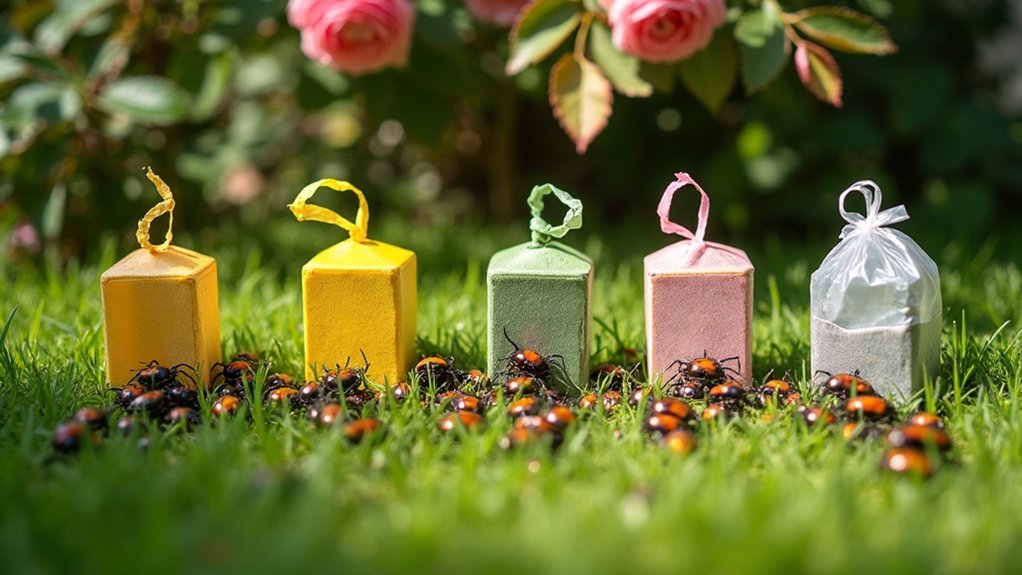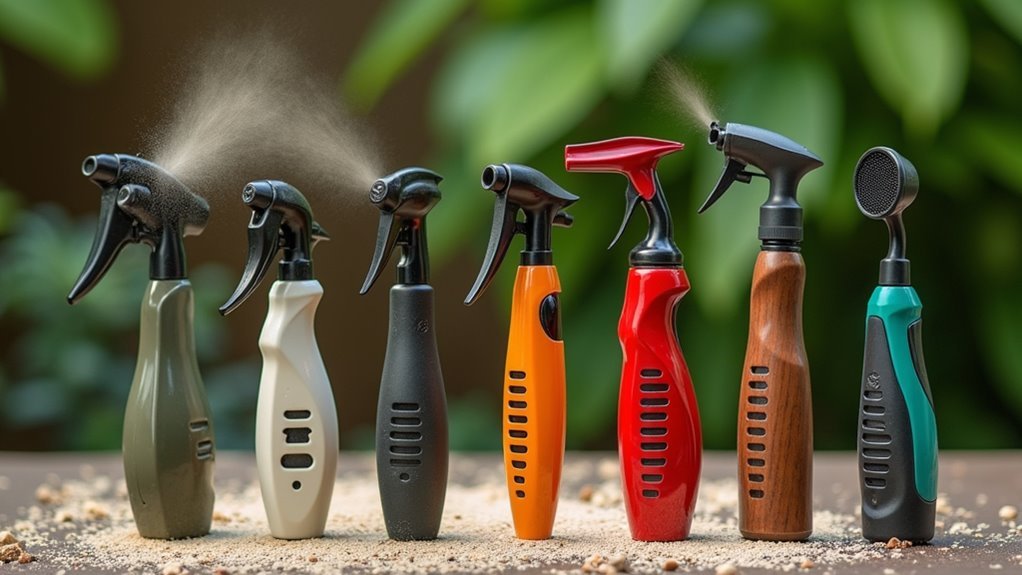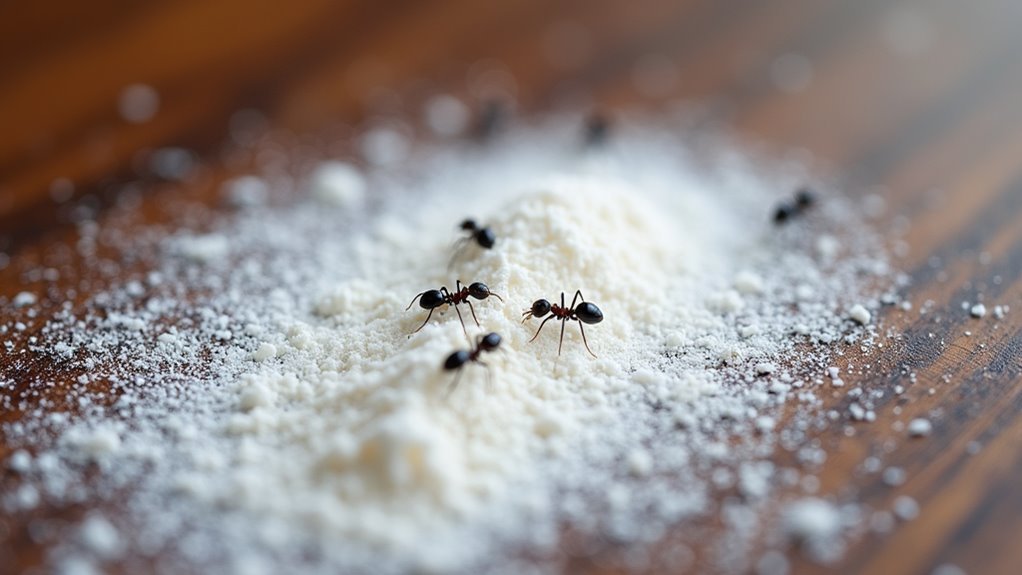If you’ve ever watched Japanese beetles decimate your garden, you know the frustration these metallic pests bring. You’re not alone in this battle—millions of gardeners face the same challenge every summer. The right trap with effective attractants can make all the difference between saving your roses and watching them turn into skeletal remains. But which traps actually work and which ones just attract more beetles to your yard? The answer might surprise you when you consider these five proven options.
Catchmaster Japanese Beetle Traps with Pheromone Lure (6 Pack)
The dual-threat lure system makes Catchmaster’s 6-pack trap collection a powerhouse for gardeners facing severe beetle infestations. You’ll capture 2-5 times more beetles than single-lure alternatives thanks to the combination of sex and floral attractants that target both male and female pests.
Each trap covers 5,000 square feet and lasts an entire season. Simply assemble the cross-shaped vanes, attach the escape-proof collection bag, and hang your trap 10-30 feet from valued plants. For ideal results, position traps 3-5 feet high in sunny locations on the upwind side of your garden.
Best For: Homeowners and gardeners with extensive yards (5,000+ square feet) facing severe Japanese beetle infestations who want a season-long, low-maintenance solution to protect their ornamentals, fruit trees, vegetables, and flowers.
Pros:
- Dual pheromone system attracts 2-5 times more beetles than single-lure traps by targeting both male and female beetles
- Large coverage area (5,000 square feet) with season-long effectiveness from a single installation
- Escape-proof collection bags with simple assembly and strategic placement recommendations for maximum effectiveness
Cons:
- Requires proper placement (10-30 feet away from protected plants) to avoid accidentally attracting beetles to valued plants
- Collection bags need monitoring and replacement when full, requiring periodic maintenance
- May be more expensive than single-lure alternatives or other beetle control methods
Safer Brand 70102 Japanese Beetle Trap with Attractant
Gardeners seeking an American-made solution to Japanese beetle infestations will find Safer Brand’s 70102 trap particularly appealing. This lightweight alloy steel trap uses a dual-action attractant system that disrupts mating cycles while luring beetles away from your plants.
The package includes everything you’ll need: trap, lure, two jumbo collection bags, and a 48-inch collapsible galvanized stand. For ideal results, place the trap at least 10 feet from valued plants—many users recommend even greater distances for better effectiveness.
While its 4.2-star rating shows general satisfaction, some gardeners prefer combining this trap with milky spore treatments for thorough beetle management.
Best For: Gardeners struggling with Japanese beetle infestations who want an American-made, non-toxic solution that captures beetles before they damage plants.
Pros:
- Complete kit includes trap, lure, collection bags, and a 48-inch collapsible stand for immediate setup
- Dual-action food and sex attractant system disrupts mating cycles while luring beetles away from plants
- Made in the USA with durable alloy steel construction that withstands outdoor conditions
Cons:
- Must be placed at least 10 feet (some users recommend farther) from valued plants to prevent attracting beetles to those areas
- Mixed effectiveness according to user reviews, with some reporting limited capture results
- May need to be combined with other treatments like milky spore for comprehensive beetle management
Spectracide Bag-A-Bug Japanese Beetle Trap (Pack of 3)
Coming in a convenient pack of three, the Spectracide Bag-A-Bug Japanese Beetle Trap offers an environmentally friendly solution for anyone battling persistent beetle infestations.
These metallic traps utilize beetles’ natural sex attractant, capturing 2-5 times more pests when combined with floral lures. For best results, hang traps in trees away from plants you’re protecting and replace bags when half-full.
Users report significant population reduction over successive seasons, with traps filling quickly during peak beetle activity. The 4.5-star rating from over 1,800 customers confirms their effectiveness. For larger properties, consider using multiple sets—many gardeners recommend four traps for half-acre lots.
Best For: Homeowners with Japanese beetle infestations who want an environmentally friendly, chemical-free solution that provides long-term population control.
Pros:
- Highly effective trap system that uses natural sex attractants to capture large quantities of beetles
- Comes in a convenient pack of three, making it suitable for covering larger properties
- Shows improved results over multiple seasons with consistent use, as reported by customers
Cons:
- Bags fill quickly during peak season and require regular monitoring and replacement
- Must be positioned away from plants you want to protect, which requires strategic placement
- Some customers reported issues with shipping, though they were satisfied with the product itself
RESCUE! Japanese Beetle Trap – Reusable Bag – 2 Traps
When Japanese beetles threaten to devastate your garden, RESCUE! traps offer an effective solution. Each trap uses pheromone attractants to lure Japanese and Oriental beetles, which then fly into the green panels, get stunned, and fall into the attached bag with no escape.
You’ll appreciate the reusable design—each attractant cartridge lasts a full season, and the easy-lock bottom allows for simple emptying. Place traps at least 30 feet from your prized plants for best results. Users report catching hundreds of beetles within days, earning these USA-made traps a 4.3-star rating from over 2,700 customers.
Best For: Home gardeners and landscapers dealing with Japanese or Oriental beetle infestations who need an effective, reusable solution that keeps beetles away from valuable plants.
Pros:
- Effectively traps hundreds of beetles with pheromone attractants that last an entire season
- Reusable design with easy-lock bottom for simple emptying and continued use
- Made in the USA with 4.3-star rating from over 2,700 customers
Cons:
- Requires placement at least 30 feet away from ornamental plants to be effective
- May have stability issues in windy conditions requiring additional securing
- Works best as part of a comprehensive pest management approach rather than as a standalone solution
Spectracide Bag-A-Bug Japanese Beetle Trap Replacement Lure Refill
The dual-action lure system makes this Spectracide refill a powerful weapon against destructive Japanese beetles. Combining a natural sex attractant with a floral lure, it attracts 2-5 times more beetles than standard options.
You’ll get approximately 12 weeks of effectiveness from each refill. When setting up, remember to hang traps at least 20 feet from your valuable plants to avoid inadvertently drawing beetles to them.
For best results, check traps regularly, empty the collection bags, and rinse the lure. Many gardeners report significant beetle population reductions after consistent use, especially in subsequent seasons.
Best For: Homeowners and gardeners with Japanese beetle infestations who want an effective, targeted solution to protect their roses, grapes, fruit trees, and vegetable plants.
Pros:
- Dual lure system attracts 2-5 times more beetles than standard floral lures alone, providing superior capture rates
- Long-lasting effectiveness of approximately 12 weeks per refill offers season-long protection
- Compatible with the existing Spectracide Bag-A-Bug trap system, making replacement simple and cost-effective
Cons:
- Requires separate purchase of the trap system, as this is only a refill component
- Must be placed at least 20 feet from valuable plants to avoid initially attracting more beetles to those areas
- Regular maintenance needed (emptying bags, rinsing lure) to maintain effectiveness and prevent unpleasant odors
Factors to Consider When Choosing the Most Effective Japanese Beetle Traps With Proven Attractants
When selecting Japanese beetle traps, you’ll need to evaluate the effectiveness of different lure types, which can dramatically impact your capture rates. Consider both the coverage area size of the trap and strategic placement locations to maximize beetle interception without attracting more pests to untreated areas. The trap’s durability in various weather conditions and how easily you can empty and maintain it will determine its long-term value for your garden protection strategy.
Lure Type and Effectiveness
Selecting the right attractant can make all the difference in your battle against Japanese beetles. Dual lure systems that combine sex pheromones with floral attractants are remarkably more effective, capturing 2-5 times more beetles than single-lure options. These pheromones specifically target both male and female beetles, effectively disrupting their mating cycles and reducing overall populations.
Remember that attractants lose potency over time. You’ll need to replace them every 12 weeks or when you notice their scent fading to maintain ideal capture rates. For maximum effectiveness, place your traps 10-30 feet away from plants you want to protect, creating a diversion that draws beetles away from valuable vegetation. Take advantage of sunny, warm days when beetles are most active, as environmental conditions greatly impact trap performance.
Coverage Area Size
Square footage matters considerably when selecting Japanese beetle traps for your property. The most effective traps can cover impressive spans of over 5,000 square feet, making them ideal for larger landscapes where beetle populations are widespread.
For best results, place your traps strategically—positioning them 10 to 30 feet away from valuable plants helps draw beetles away from these prized areas rather than toward them. If you’re treating substantial acreage, consider multi-pack options that allow for thorough coverage; experts recommend four traps for every 0.6 acres.
Choose traps with larger collection bags if you’re dealing with severe infestations. These require less frequent emptying, reducing maintenance while maximizing capture efficiency. Your trap’s effectiveness ultimately depends on matching its coverage capabilities to your specific property size.
Trap Placement Strategy
Proper trap placement transforms average Japanese beetle control into remarkable protection for your garden. Position traps 10-30 feet away from valued plants to avoid inadvertently drawing beetles toward them. This distance creates an effective interception zone without risking additional plant damage.
Mount your traps 3-5 feet above ground in sunny locations where they’ll be highly visible to flying beetles. For maximum effectiveness, place traps on the upwind side of your garden so prevailing winds carry the pheromone scent toward beetle populations.
Don’t forget to maintain your traps by emptying collection bags when they’re half full. This prevents the captured beetles from overwhelming the attractant’s effectiveness. For complete coverage, use multiple traps—approximately one per 0.1 acre—to create a thorough defense system around your property.
Durability in Elements
While the most attractive beetle trap becomes useless when it fails in harsh weather, investing in weather-resistant models assures season-long protection for your garden. Look for traps constructed with galvanized steel or high-quality plastic components that resist rust and corrosion when exposed to rain and moisture.
UV-resistant coatings are essential features that prevent degradation from constant sun exposure, which could otherwise compromise your trap’s structural integrity and attractant effectiveness. You’ll also want a design with secure assembly that won’t collapse or shift position during windy conditions, as stability directly impacts capture rates.
Don’t forget to regularly inspect your traps for wear and tear. Even the most durable models benefit from maintenance checks to guarantee they continue functioning effectively throughout the beetle season.
Ease of Maintenance
Maintaining your Japanese beetle trap shouldn’t become a dreaded chore that discourages consistent use. Look for traps with reusable bags or easy-lock bottoms that allow you to empty captured beetles quickly and get back to enjoying your garden.
Select models featuring controlled release attractant systems, which extend the life of your lures and reduce how often you’ll need replacements. Large-capacity collection bags mean fewer emptying sessions, even during peak beetle season.
The best traps require minimal assembly and come with clear instructions for proper placement and management. You’ll want a design that’s intuitive to set up and position in your yard’s beetle hotspots. When maintenance is straightforward, you’re more likely to keep your traps functioning effectively throughout the entire Japanese beetle season.
Environmental Safety Considerations
Selecting eco-friendly Japanese beetle traps offers benefits beyond just controlling pests in your garden. Many modern traps use non-toxic attractants that won’t harm beneficial insects or wildlife while effectively targeting Japanese beetles. This approach greatly reduces your need for chemical pesticides, creating a healthier ecosystem throughout your landscape.
Look for traps made with biodegradable materials to minimize environmental waste compared to plastic alternatives. Proper placement is essential—position your traps 10-30 feet away from plants you want to protect to avoid inadvertently drawing beetles to your prized specimens.
For best results, choose models with controlled release systems that dispense attractants gradually. These systems maintain effectiveness throughout the beetle season while minimizing environmental impact and extending the functional life of your trap.
Frequently Asked Questions
How Far Apart Should Japanese Beetle Traps Be Placed?
Place your Japanese beetle traps 30-50 feet apart and at least 30 feet away from plants you want to protect. They’ll attract beetles from a distance, so proper spacing prevents unwanted pest concentration in your garden.
Can Japanese Beetle Traps Attract More Beetles to My Yard?
Yes, Japanese beetle traps can actually attract more beetles to your yard than they catch. You’ll likely end up with increased beetle activity nearby, potentially worsening damage to your plants.
When Is the Best Time to Set up Japanese Beetle Traps?
You’ll want to set up Japanese beetle traps in late May or early June, just before adults emerge. Place them far from plants you’re protecting, as they’ll attract beetles before they cause damage.
How Often Should Trap Attractants Be Replaced?
You’ll need to replace Japanese beetle trap attractants every 4-6 weeks during beetle season. If you notice decreased trap effectiveness or after heavy rain, don’t wait—replace them sooner to maintain ideal beetle-catching results.
Do Japanese Beetle Traps Work for Other Garden Pests?
Japanese beetle traps won’t work for other garden pests. They’re specifically designed with attractants for this beetle species only. If you’re dealing with different pests, you’ll need traps tailored to those specific insects.





Leave a Reply